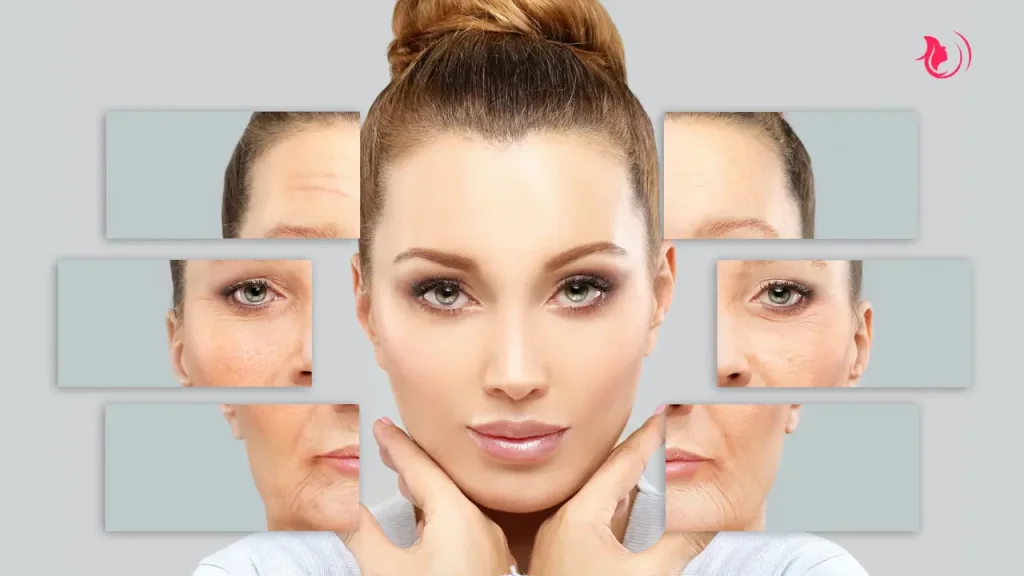Let’s start with a definition, as our skin, is just one of our many organs. Our skin is a remarkable organ, in fact, capable of regenerating itself every 27 days. However, as we age, this process begins to slow down, leading to visible signs of ageing like wrinkles and fine lines. But what you might not realize is that the invisible damage occurring beneath the skin’s surface plays a significant role in this process.
Starting around the age of 20, the skin’s fibroblasts, the cells responsible for producing collagen and elastin, begin to decrease. These proteins are vital for maintaining the structure and elasticity of the skin. As their production slows, the skin starts losing its firmness and suppleness, leading to the formation of wrinkles and other signs of ageing.
Wrinkles
Wrinkles, often the first sign of aging, are lines and creases that form in your skin. They primarily appear on areas of the body that receive the most sun exposure, including the face, neck, back of the hands, and tops of the forearms. Wrinkles fall into two categories:
- fine surface lines (caused by ultraviolet light damage) and
- deeper furrows (caused by muscle contractions from facial expressions like smiling and frowning)
Many factors contribute to the development of wrinkles. As we age, our skin naturally becomes less elastic and more fragile. Decreased production of natural oils can make the skin appear more wrinkled. Habits like smoking can accelerate the ageing process of the skin, contributing to wrinkles. Prolonged exposure to UV light breaks down the connective tissue (collagen and elastin fibres), which lies in the deeper layer of skin (dermis). Without supportive connective tissue, the skin loses its strength and flexibility, leading to wrinkles.
Sagging Skin
Sagging skin is a common sign of ageing and is characterized by the loosening or drooping of skin. As we grow older, our skin loses its elasticity due to the reduction in the production of collagen and elastin, two proteins that help our skin stay firm, plump, and resilient. In addition to the natural ageing process, various environmental factors such as UV radiation and lifestyle choices, including diet and smoking, can speed up the loss of these vital proteins, leading to premature sagging of the skin.
In addition to ageing and environmental factors, rapid weight loss can also cause skin sagging. When you lose weight quickly, your skin doesn’t have enough time to shrink down to your body’s new size, resulting in loose, sagging skin. It’s important to note that while some level of skin sagging is inevitable with age, there are several treatments and skincare practices that can help slow down the process and improve the appearance of sagging skin. These include regular exercise to maintain muscle tone, a balanced diet rich in antioxidants, vitamins, and minerals, and topical creams and serums that boost collagen and elastin production.
The Importance of Moisturizing
One of the most effective ways to combat skin ageing is by keeping the skin hydrated. Everyone now knows that but we need to keep reminded. Moisturizing helps maintain the skin’s natural protective barrier, preventing environmental factors like pollution and UV radiation from causing further damage. Moreover, well-hydrated skin is more plump and resilient, which can reduce the appearance of fine lines and wrinkles.
Anti-ageing treatments such as skin booster treatments can also play a crucial role in maintaining youthful skin. These treatments deliver deep hydration, nourishing the skin from within and stimulating the production of collagen and elastin. By replenishing the skin’s moisture levels, skin booster treatments can help prevent further ageing and restore a more youthful appearance.
How to Keep Your Skin Hydrated
-
Moisturize Daily: Apply a good quality moisturizer to your skin daily to lock in moisture and prevent dryness.
-
Use Hydrating Masks: Regular use of hydrating face masks can provide your skin with extra moisture and nutrients.
-
Opt for Hydrating Cleansers: Choose a cleanser that doesn’t strip your skin of its natural oils.
-
Daily Water Intake: It’s crucial to drink at least 8 glasses of water each day. This amount should increase if you’re physically active or if the weather is particularly hot.
-
Hydrating Alternatives: If you find drinking plain water boring, switch things up with alternatives like fruit juices, herbal teas, and coconut water. These options not only help hydrate your body but also provide essential nutrients. However, be mindful of the sugar content in some beverages.
-
Hydrating Foods: Incorporate more water-rich foods into your diet. Fruits like watermelon, oranges, and strawberries, and vegetables like cucumbers, lettuce, and zucchini are excellent choices.
Lifestyle Changes for Healthy Skin
In addition to a good skincare routine, certain well-known lifestyle changes can also help protect your skin and keep it looking youthful for longer:
- Sun Protection: Prolonged exposure to the sun’s harmful UV rays can accelerate skin aging. Always wear sunscreen with a high SPF, even on cloudy days, and reapply it every two hours when outdoors.
- Healthy Diet: A diet rich in fruits, vegetables, lean proteins, and healthy fats can provide the nutrients your skin needs to stay healthy. Foods high in antioxidants can also help protect your skin from damage.
- Adequate Sleep: During sleep, your skin repairs and regenerates itself. Make sure to get at least 7-8 hours of quality sleep each night.
- Regular Exercise: Regular physical activity improves circulation, helping to nourish skin cells and keep them vital.
Final Thoughts
While ageing is very much a natural process, understanding the invisible damage that contributes to it can help us take proactive steps to maintain our skin’s health and youthfulness. Remember, it’s never too early or too late to start taking care of your skin. With the right skincare routine, treatments, and lifestyle habits, you can protect your skin and keep it looking radiant for years to come. So what are you waiting for? Start today.


